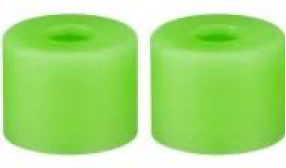
Basic Introduction to (Riptide™) Longboard Bushing Behavior
Formulas
Riptide offers their bushings in three formulas; APS, WFB, and KranK.
-
Animated Polymer Systems – Provides a linear turning experience and quick, snappy return-to-centre. Excellent choice for riders looking for more bounce out of their carves or pumps.
- They come in 70a, 75a, 80a, 85a, 90a, 92.5a, 95a, and 97.5a
(ED: there are more duros coming online from Riptide so do check out our online shop for more details)
- They come in 70a, 75a, 80a, 85a, 90a, 92.5a, 95a, and 97.5a
-
World’s Fastest Bushings – These bushings provide a faster turning experience, but slightly slower return-to-centre. Ideal for riders who like to get technical riding down hills and railing the apex of each turn.
- They come in 68a, 73a, 78a, 83a, 88a, 93a, and 95.5a
-
KranK – Built for Performance Under Pressure, these bushings are made from a high rebound formula that hardens when compressed. Ideal for riders who like doing everything on one singular setup, be it dancing, downhill, freeride or street skating. This formula can be ridden loosely for a livelier feel, or KranK’d down for a stiffer feel.
- They come in 84a, 87a, 90a, 93a and 96a
Riding bushings based solely on their behaviour or durometer may not be optimal as bushings (even from various other brands) come in different shapes. So, let’s talk about those.
Starting with one of the most basic shapes:
Barrel Bushings
|
Riptide Barrel Bushings

|
If there was ever a base, neutral ground, what a “Normal” type would be in Pokémon, but as a bushing, it would be the barrel bushing. Typically, a stock set of trucks, right out of the shop would come with barrels. Barrel bushings provide a steady lean when turning and decent resistance when carving around or when you’re throwing a trick in the air or a slide down a hill. You can’t go wrong riding barrels. However, if riding these don’t suit your style, you could bumping the resistance a notch or take it down a peg. |
Speaking of lower resistance:
Cone Bushings
|
Cone bushings provide the least resistance when turning compare to the rest of the bushing family. Ideal for lighter riders, or riders who want their setups to absolutely dive into the turns as opposed to a more stable setup for average riders. Great for riders with a smaller stature, children, and dances who carve up a storm as they slither beautifully down the path. I wouldn’t outright say they’re not great for downhill skating (as it depends on what the rider prefers), but given the fact that offer little to no resistance when turning, you might feel twitchy or get the case of the wobbles when moving too fast.
|
Riptide Cones Bushings
 |
There are a handful of people who feel just fine riding cones at higher speeds. It could be the fact that they’re in tuned to their setups and they know just what formula/bushing shape combination to go for. So if you’re a featherlite rider, who absolutely needs to ride a cone bushing for fast paced riding, consider riding a set of cones, and go figure which formula/bushing shape combo you should go for.
FatCone Bushings
But maybe you’d like something like a barrel, but a tad bit more resistance. Like, you’d like a McSpicy, but a Zinger from KFC is more your bite. Fatcone may be your choice of bushing!
|
Riptide Fatcone Bushings

|
These bushings provide about the same about of resistance as a barrel, however you’ll find that it’s threshold increases and you lean into the turn. |
These bushings are great for riders who want more gradual dive during carves and slightly more rebound during return-to-centre. My personal favourite as a larger rider.
Some riders prefer not to have a gradual lean. Some actually prefer to have a ton of resistance to stop them from leaning or turning too much, either to stop speed wobbles or for a more stable ride on a setup that’s way too small.
For such riders, I’d recommend using these:
Chubby Bushing
|
Because of its shape, they provide an extremely linear turn, keeping the entire setup very stable at extreme speeds and in situations where you wouldn’t want the board to turn much to begin with. Situations where this bushing shape would not perform optimally would include but not limited to: freestyle dance, beach cruising, park skating, dog walking, etc. What I’m getting at is this bushing shape is rather extreme and very circumstantial. |
Riptide Chubby Bushings

|
They’re also just as wide as the larger side of the fat cone, so do check from your truck manufacturer if these would fit in your bushing seat. Because of its large size contributing to how much it would resist your weight as your turn, riders usually ride a barrel on the road side with a chubby on the board side to balance the tolerances in its entirety.
Special Bushing Shapes
Riptide makes specialized bushings for Paris and Paris Savant trucks. They are the Canon and Magnum bushings.
Canon & Magnum Bushing
These trucks have an impressive bushing seat, however, fat cones and chubby bushings may not fit or function as intended. As such, special bushing shapes are made to have them function similarly to a fat cone or chubby bushing.
Their tolerances are similar to that of a barrel. The canon has slightly larger outer diameter, with more resistance than a standard barrel. And the magnum is basically a chubby that can fit in a Paris hangar with the same functionality without any drawbacks.
Ideally, riding a canon roadside along with magnum roadside has proved to be optimal as it creates a triangulared point of tolerance. Also, because the canon is wider, it also provides more rebound. Riding a set of canons in each of your truck would also be optimal.
|
Riptide Canon Bushings

|
Riptide Magnum Bushings

|
Cube Bushing
|
Riptide Cube Bushings

|
The cube bushings are an interesting one. Being shaped as such allows for very interesting results. I personally have not used them, but Riptide has mentioned in their website that depending on how they are orientated, they yield different results.
Apparently, they generally feel like riding barrels while oriented diamond-like, providing a nice linear lean; and while oriented cube-like, it provides a more progressive lean. Riding these, you could orient them however you’d like, with an assortment of different bushing shapes. |
Combinations
Case Study 1
Say you’re a rider who focuses on dancing, about 50kg (110lbs) and approximately 169cm (5’5”) tall, and would like a somewhat bouncy, carvy, lively setup. You could go with:
- APS Bushings as they provide the most rebound out of the three available formulas. Although KranK might be a good pick as well.
- Barrel and canon bushings provide the most rebound and consistent return to centre. Riding these as a combo might be a good idea. Riding canons on canons might impede on each other’s rebound and could cause the setup to be too tight.
- A 90a KranK cone road side accompanied with an 85a APS canon boardside would be an experimental pick. Although the KranK bushing is a harder bushing which should be on the boardside, it does still have a lower tolerance than the APS canon that’s on the boardside. At the same time, the riding the setup with the kingpin completely flush would set it as its base overall tolerance and the rider could increase the setup’s tolerances by KranKing it down a notch or two.
Case Study 2
A rider who focuses on freeride and downhill, approximately 120kg (264lbs), 175cm (5’ 9”) tall, who has been using unknown bushings for a while, wants to make a downhill, speed oriented setup. They could go with:
- WFB bushings would be a great pick as it’s not as reactive and responsive to deter speed wobbles. Having an APS on the boardside might help give a tad bit of responsive to help with the return-to-centre during pumps, carves or returning the board under their feet after a slide.
- 93a WFB barrels on the roadside accompanied with 95a APS fatcones boardside should provide a playful medium between freeride and downhill.
- An extreme setup would consist of 93a KranK barrel roadside accompanied with 92.5a APS chubby. The KranK barrel would provide the peudo-high responsiveness needed to weave between riders of today’s standards, and the APS chubby would dampen any excess responsiveness so the ride can lean as hard as they want around corners without the worry of getting speed wobbles.
Case Study 3
New to skating on hills, this new rider would like to start learning to freeride. They have no prior experience to skating, but already as a setup. They feel very insecure while going down a hill with the current stock setup but very eager to learn. They weigh approximately 65kg (143.3 lbs) and about 170cm (5’5”) tall. They should get:
- The easiest bushing shape to get used to would be the barrel as they offer decent lean and resistance. Going any higher or lower might cause the rider to not be able to turn properly and impede their progression.
- Picking you formula for a beginner might be pretty hard as newer riders have yet to develop a preference. However, I do find that beginners do feel that WFBs tend to treat them well. Adding a KranK might help them down the line when they’d like to tighten tolerances.
- Two sets of 88a WFB barrels should work well with someone of this weight class. Despite being on the slightly softer side, being WFB should prevent the rider from getting speed wobbles, even a little bit. If they still feel insecure, they could bump it up to a fatcone instead.
Conclusion
I’d like to say that this article is not the be-all and end-all on bushings. There are many different manufacturers and brands, and they all make their bushings differently, with different formula pours and shapes and sizes.
Always check with your retailers and manufacturers and ask if your choice of bushing is right for you, and if they’re compatible with your ride. I’ve only mention 3 of the most popular styles of skating in the scenarios, but someone who does long distance pushing, or street/park skating may prefer a different setup.
About the Author
Sora Noize. Rider, filmer, all around nice guy. This article was written from experience in riding, observations and research. 100% non-profit and for the public.
Contacts
- @soranoize (Twitter & Instagram)
- com/sora.noize
- soranoize@gmail.com
